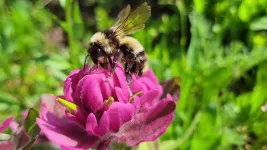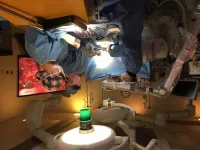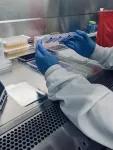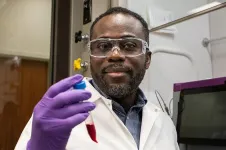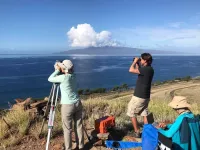(Press-News.org) On a cliffside at Mesa Verde National Park in southern Colorado, a fuzzy bee was industriously gnawing at the red sandstone. Making a loud grinding sound, the insect used its powerful jaws to drill tunnels and holes in rocks, where it would build a nest for raising offspring.
The bee, known as Anthophora pueblo, is a type of digger bee native to Colorado. Discovered less than a decade ago, the bee has quickly become Adrian Carper’s favorite pollinator.
“This is just one example of how crazily diverse our native bees are,” said Carper, an entomologist in the Department of Ecology and Evolutionary Biology at the University of Colorado Boulder and the CU Museum of Natural History.
But those pollinators are in peril as a result of human activities, according to the first comprehensive report on Colorado’s native pollinating insects published by Carper and his collaborators earlier this month.
The report summarized research on native pollinators in Colorado and found that in the last 35 years, populations of some pollinator species in the state have dropped by more than half. About 20% of Colorado’s 24 native bumblebee species are currently seeking federal protection by the Endangered Species Act due to a significant decline in their populations.
“That’s a huge alarm call, and that’s only for species we have good data for,” Carper said, adding that this is likely an underestimate of the danger Colorado’s native pollinating insects are facing.
In addition to bees and butterflies, other insects like beetles, flies and even mosquitoes also pollinate—many of them remain understudied. The report highlighted data from the Rocky Mountain Biological Laboratory, where even in a well-protected high-elevation meadow, the number of insects living there has dropped by 61% over the last 35 years.
Native pollinators are critical to Colorado’s ecosystem, agriculture and tourism industry.
For example, the world-famous Rocky Ford cantaloupes, native to the small town in southeastern Colorado, are best pollinated by the state’s native squash bees. These bees have evolved special hairs to carry the cantaloupe’s particularly large pollen grains. In contrast, honeybees lack these special hairs and are inefficient at pollinating cantaloupe flowers.
“Our native bees have co-evolved with our native plants. We recreate in our beautiful high alpine mountains, because they are covered in colorful wildflowers, which wouldn’t be there if they didn't have our native pollinators to help them reproduce. Additionally, those native plants are integral to our rangelands, supporting over $5 billion worth of livestock across the state,” Carper said.
According to the report, habitat loss, pesticides, climate change and non-native species including honeybees, are the main threats to native pollinators’ survival.
Insects are cold-blooded animals that rely on the environment to regulate their body temperature. Many pollinators might not tolerate higher temperatures, and extreme weather events like droughts and floods could wipe out insect habitats. Climate change also affects when and how many plants are flowering, influencing the availability of nectar and pollen, which are the key sources of food for pollinators.
Despite being an important agricultural pollinator, the western honeybee is a non-native species to Colorado. But with a growing interest in beekeeping, Colorado has seen a surge in the numbers of urban honeybee hives in recent years. Research has shown that these honeybees could compete with native bees for food, and potentially spread diseases and parasites.
“We need to better educate beekeepers on subjects like disease management and swarm control to mitigate honeybees’ impacts on native pollinators,” Carper said.
The report highlighted priorities for the state to conserve native pollinators, including creating and connecting patches of habitat to allow pollinators to move between areas, and reducing pesticide use.
For individuals, there is also room for action, Carper said.
“Planting with native plants in our own backyards can certainly support our native pollinators.”
END
One in five Colorado bumblebees are endangered, new report says
2024-01-24
ELSE PRESS RELEASES FROM THIS DATE:
Mayo Clinic study explores heart failure, uncovers gene’s role in recovery
2024-01-24
Mayo Clinic researchers studying the genetics of people who had recently developed dilated cardiomyopathy, one of the most common causes of heart failure, have found a particular gene to target for developing future drug therapy treatments. The disease makes it harder for the heart's left ventricle to pump blood effectively to the rest of the body. In this first genome-wide association study, the researchers sought to understand why some patients get better after developing the condition — and some don't.
"We found genetic variation in the CDCP1 gene, a gene that no one has heard of in ...
How studying defensive bacteria may help human gut health
2024-01-24
MSU has a satellite uplink/LTN TV studio and Comrex line for radio interviews upon request.
Images
EAST LANSING, Mich. – Thousands of types of bacteria live in the human gut. They help digest the food we eat and absorb nutrients, but these bacteria don’t just do this to be kind to humans, there is a benefit for them too.
Elizabeth Heath-Heckman, an assistant professor in the College of Natural Science, has received a five-year National Institutes of Health grant from the National Institute for General Medical Sciences totaling $1.9 million to support her research studying ...
Study: This protein may be the ‘glue’ that helps COVID virus stick
2024-01-24
When SARS-CoV-2 enters the human body, the virus’ spike protein binds to a cell, allowing the virus to infiltrate and begin replicating.
A new study from Tulane University, conducted in partnership with Florida International University and published in Protein Science, has identified a protein that may be the glue that helps COVID’s spike protein stick.
The study found that a small piece of a proteoglycan called perlecan LG3 – a protein most commonly found in blood vessels and the brain – ...
Can we predict when a migraine attack will occur?
2024-01-24
EMBARGOED FOR RELEASE UNTIL 4 P.M. ET, WEDNESDAY, JANUARY 24, 2024
MINNEAPOLIS – Migraine is often underdiagnosed and untreated, and even when it is treated, it can be difficult to treat early enough as well as find strategies to prevent attacks. A new study looks at ways to more accurately predict when a migraine will occur—through the use of mobile apps to track sleep, energy, emotions and stress—to enhance the ability to prevent attacks. The study is published in the January 24, 2024, online issue of Neurology®, the medical journal of ...
Researchers suggest changing gold standard of spine surgery from operative microscope to 3D exoscope
2024-01-24
While surgeons have more commonly used the exoscope in various intracranial procedures, its use in spinal surgery has been underreported.
Researchers and neurosurgeons at the Medical University of South Carolina (MUSC) retrospectively compared the operative microscope to the 3D exoscope in a recent study published in World Neurosurgery and found better outcomes among both surgeons and patients when using the exoscope.
Stephen Kalhorn, M.D., FAANS, was the principal investigator on the study, and he says the traditional operative microscope has ...
ORNL wins five Federal Laboratory Consortium awards
2024-01-24
Researchers, staff members and licensees from the Department of Energy’s Oak Ridge National Laboratory received top honors in the Federal Laboratory Consortium’s annual awards competition for excellence in technology transfer, excellence in technology transfer innovation, outstanding researcher and regional technology transfer.
The Federal Laboratory Consortium, or FLC, recently announced 32 award winners, ORNL included, for contributions to technology transfer, which turns cutting-edge research into impactful products and services. The FLC represents more than 300 federal laboratories, agencies and research centers ...
Foodborne-pathogen Listeria may hide from sanitizers in biofilms
2024-01-24
UNIVERSITY PARK, Pa. — An estimated 1,600 people in the U.S. contract a serious infection from Listeria bacteria in food each year and, of those individuals, about 260 people die, according to the Centers for Disease Control and Prevention. Penn State researchers may now better understand how the bacteria, called Listeria monocytogenes, survive and persist in fruit-packing plants by evading and surviving sanitizers.
According to their study, which is now available online and will be published in the June issue of the journal Biofilm, biofilms — comprising otherwise harmless microorganisms that attach to each ...
Purdue Innovates awards Purdue researchers $150K to develop innovations for the marketplace
2024-01-24
WEST LAFAYETTE, Ind. – Four researchers in Purdue University’s colleges of Engineering and Science, the Purdue Institute for Cancer Research and the Purdue Institute for Drug Discovery have received a total of $150,000 from the Trask Innovation Fund to strengthen the appeal of their patent-pending intellectual property for commercial use.
The fund is managed by the Purdue Innovates Incubator, which provides programming for the Purdue University community to ideate, refine and support their solutions. The fund awards up to $50,000 for short-term projects that enhance the commercial value of Purdue intellectual ...
JMIR Bioinformatics and Biotechnology invites submissions for research papers on machine learning-driven genomic predictive models
2024-01-24
JMIR Publications is pleased to announce a new theme issue titled “Machine Learning-Based Predictive Models Using Genomic Data” in JMIR Bioinformatics and Biotechnology. The peer-reviewed journal is indexed in SCOPUS and focused on research in bioinformatics, computational biology, and biotechnology. This new theme issue aims to explore cutting-edge research at the intersection of machine learning and genomics, fostering advancements in predictive modeling for biological insights.
JMIR Bioinformatics and Biotechnology welcomes contributions from global researchers, educators, and practitioners. We encourage submissions exploring diverse aspects of bioinformatics ...
Humpback whales move daytime singing offshore, research reveals
2024-01-24
Humpback whale singing dominates the marine soundscape during winter months off Maui. However, despite decades of research, many questions regarding humpback whale behavior and song remain unanswered. New research revealed a daily pattern wherein whales move their singing away from shore throughout the day and return to the nearshore in the evening. The findings were led by the University of Hawaiʻi, in partnership with NOAA’s Hawaiian Islands Humpback Whale National Marine Sanctuary, and published in Royal Society Open Science.
“Singers may be attempting to reduce the chances of their song being drowned ...
